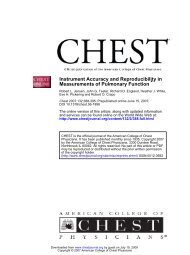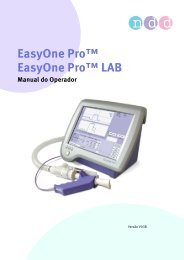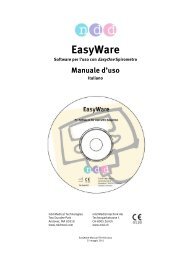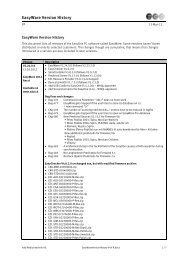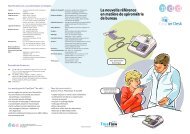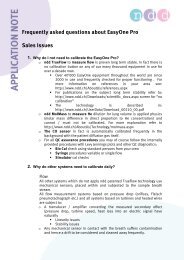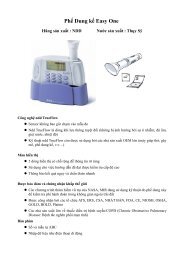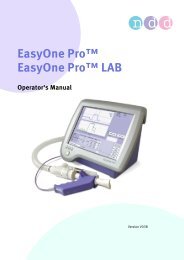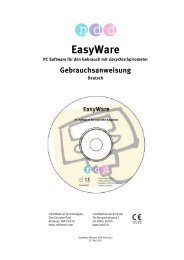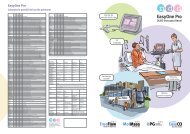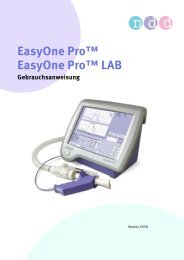Stability of the EasyOne ultrasonic spirometer for use in general ...
Stability of the EasyOne ultrasonic spirometer for use in general ...
Stability of the EasyOne ultrasonic spirometer for use in general ...
Create successful ePaper yourself
Turn your PDF publications into a flip-book with our unique Google optimized e-Paper software.
Calibration <strong>of</strong> an <strong>ultrasonic</strong> <strong>spirometer</strong> 309<br />
Measured–target volume (L)<br />
Measured–target volume (L)<br />
0.5<br />
0.4<br />
0.3<br />
0.2<br />
0.1<br />
0.0<br />
–0.1<br />
–0.2<br />
–0.3<br />
–0.4<br />
–0.5<br />
0.5<br />
0.4<br />
0.3<br />
0.2<br />
0.1<br />
0.0<br />
–0.1<br />
–0.2<br />
–0.3<br />
–0.4<br />
Dedicated Spirette<br />
0.0 1.0 2.0 3.0 4.0 5.0 6.0 7.0 8.0 9.0<br />
Random Spirettes<br />
–0.5<br />
0.0 1.0 2.0 3.0 4.0 5.0 6.0 7.0 8.0 9.0<br />
Mean calibration flow (L/s)<br />
Figure 2 Accuracy <strong>of</strong> <strong>the</strong> expiratory (solid circles) and<br />
<strong>in</strong>spiratory (open circles) calibrations checks us<strong>in</strong>g a 3-L<br />
syr<strong>in</strong>ge <strong>for</strong> all six <strong>spirometer</strong>s as a function <strong>of</strong> <strong>the</strong> mean flow<br />
generated dur<strong>in</strong>g <strong>the</strong> calibration (n = 75). Shown is <strong>the</strong> difference<br />
between <strong>the</strong> measured and target volume (3.00 L)<br />
us<strong>in</strong>g dedicated and random spirettes. The l<strong>in</strong>es show <strong>the</strong><br />
upper and lower American Thoracic Society and European<br />
Respirology Society accuracy limits (2.895 and 3.105 L)<br />
when deliver<strong>in</strong>g 3.00 L. 6<br />
to <strong>the</strong> operator on <strong>the</strong> quality <strong>of</strong> each test, <strong>the</strong> unit<br />
itself can store up to 700 patient results, and <strong>the</strong> risk <strong>of</strong><br />
cross-<strong>in</strong>fection is m<strong>in</strong>imized by us<strong>in</strong>g disposable<br />
spirettes. These features, toge<strong>the</strong>r with <strong>the</strong> stability <strong>of</strong><br />
<strong>the</strong> calibration, should help improve <strong>the</strong> quality <strong>of</strong><br />
spirometry <strong>in</strong> primary care.<br />
Although this study has confirmed <strong>the</strong> stability <strong>of</strong><br />
<strong>the</strong> volume accuracy <strong>of</strong> <strong>the</strong> <strong>EasyOne</strong> <strong>spirometer</strong>, <strong>the</strong><br />
authors found small differences between syr<strong>in</strong>ge calibrations<br />
us<strong>in</strong>g dedicated and random spirettes.<br />
These differences are probably related to m<strong>in</strong>or variations<br />
<strong>in</strong> cross-sectional area, as <strong>the</strong> <strong>spirometer</strong><br />
obta<strong>in</strong>s volume by <strong>in</strong>tegrat<strong>in</strong>g <strong>the</strong> flow signal with<br />
respect to time, and flow is derived by divid<strong>in</strong>g <strong>the</strong><br />
measured gas velocity by <strong>the</strong> <strong>in</strong>ternal cross-sectional<br />
area <strong>of</strong> <strong>the</strong> spirette. However, as variability between<br />
calibrations was similar <strong>for</strong> <strong>the</strong> one dedicated and <strong>the</strong><br />
random spirettes, this <strong>in</strong>dicates that <strong>the</strong> manufactur<strong>in</strong>g<br />
tolerances (i.e. with respect to variations <strong>in</strong> <strong>in</strong>ternal<br />
cross-sectional area) were very small. The authors’<br />
observation that <strong>the</strong> volume recorded dur<strong>in</strong>g <strong>the</strong><br />
expiratory calibration was about 0.04 L higher than<br />
dur<strong>in</strong>g <strong>the</strong> <strong>in</strong>spiratory calibration (Table 2) is probably<br />
due to a comb<strong>in</strong>ation <strong>of</strong>: (i) <strong>the</strong> different flow<br />
geometries upstream and downstream <strong>of</strong> <strong>the</strong><br />
spirettes and (ii) m<strong>in</strong>or differences <strong>in</strong> temperature<br />
between <strong>the</strong> syr<strong>in</strong>ge and <strong>in</strong>spired gas. The latter can<br />
be ca<strong>use</strong>d by frequent handl<strong>in</strong>g <strong>of</strong> <strong>the</strong> syr<strong>in</strong>ge dur<strong>in</strong>g<br />
<strong>the</strong> calibration procedure.<br />
General practitioners are at <strong>the</strong> <strong>for</strong>efront <strong>of</strong> healthcare<br />
delivery and, <strong>the</strong>re<strong>for</strong>e, uniquely positioned to<br />
monitor <strong>the</strong> respiratory health <strong>of</strong> <strong>the</strong> community.<br />
In order to facilitate <strong>the</strong> <strong>in</strong>creas<strong>in</strong>g <strong>use</strong> <strong>of</strong> spirometry<br />
<strong>in</strong> primary care <strong>the</strong> Global Initiative <strong>for</strong> Chronic<br />
Obstructive Lung Disease called <strong>for</strong> <strong>the</strong> development<br />
<strong>of</strong> simple and accurate <strong>spirometer</strong>s. 3 The National<br />
Lung Health Education Program suggested that alternative<br />
solutions were needed to <strong>the</strong> daily <strong>use</strong> <strong>of</strong> 3-L<br />
calibration syr<strong>in</strong>ges to check <strong>the</strong> accuracy <strong>of</strong> <strong>spirometer</strong>s<br />
<strong>in</strong>tended <strong>for</strong> <strong>use</strong> <strong>in</strong> primary care. 2 The need <strong>for</strong><br />
this is highlighted by surveys confirm<strong>in</strong>g that daily<br />
calibration <strong>of</strong> <strong>spirometer</strong>s does not occur <strong>in</strong> primary<br />
care. As it is likely that <strong>the</strong> <strong>use</strong> <strong>of</strong> spirometry <strong>in</strong> primary<br />
care will <strong>in</strong>crease as <strong>the</strong> recommendations <strong>of</strong><br />
cl<strong>in</strong>ical guidel<strong>in</strong>es <strong>in</strong> COPD and asthma are adopted,<br />
accurate and easy-to-<strong>use</strong> <strong>spirometer</strong>s are essential.<br />
In<strong>for</strong>mation on comparative features <strong>of</strong> <strong>spirometer</strong>s<br />
is be<strong>in</strong>g made available to practices (Spirometer Buyers<br />
guide 11 ), and an important criterion when select<strong>in</strong>g<br />
a <strong>spirometer</strong> is <strong>the</strong> stability <strong>of</strong> <strong>the</strong> calibration and<br />
how frequently this needs to be checked. There will be<br />
advantages <strong>for</strong> practices <strong>in</strong> be<strong>in</strong>g able to rely on <strong>the</strong><br />
<strong>spirometer</strong> ma<strong>in</strong>ta<strong>in</strong><strong>in</strong>g its accuracy over time and<br />
cont<strong>in</strong>ued <strong>use</strong>. Current guidel<strong>in</strong>es stat<strong>in</strong>g <strong>the</strong> need <strong>for</strong><br />
daily calibration may need to be revised <strong>in</strong> <strong>the</strong> light <strong>of</strong><br />
<strong>the</strong>se f<strong>in</strong>d<strong>in</strong>gs.<br />
This study has demonstrated that <strong>the</strong> claim <strong>of</strong> stability<br />
made <strong>for</strong> <strong>the</strong> <strong>EasyOne</strong> <strong>spirometer</strong> on <strong>the</strong>oretical<br />
grounds is substantiated <strong>in</strong> primary care and, <strong>the</strong>re<strong>for</strong>e,<br />
<strong>spirometer</strong> guidel<strong>in</strong>es may need to be reviewed<br />
to reflect this.<br />
ACKNOWLEDGEMENTS<br />
The authors wish to thank Sue Davoren and Elizabeth<br />
Hammer <strong>for</strong> <strong>the</strong>ir assistance <strong>in</strong> carry<strong>in</strong>g out <strong>the</strong> calibrations.<br />
J.W. is <strong>the</strong> recipient <strong>of</strong> a GSK Postgraduate<br />
Support<strong>in</strong>g Grant.<br />
REFERENCES<br />
1 Petty TL, We<strong>in</strong>mann GG. Build<strong>in</strong>g a national strategy <strong>for</strong><br />
<strong>the</strong> prevention and managment <strong>of</strong> and research <strong>in</strong><br />
chronic obstructive pulmonary disease. National Heart,<br />
Lung and Blood Institute Workshop Summary. Be<strong>the</strong>sda.<br />
JAMA 1995; 277: 246–53.<br />
2 Ferguson GT, Enright PL, Buist S, Higg<strong>in</strong>s MW. Office<br />
spirometry <strong>for</strong> lung health assessment <strong>in</strong> adults: a consensus<br />
statement from <strong>the</strong> National Lung Health Education<br />
Program. Chest 2000; 117: 1146–61.<br />
3 Pauwels RA, Buist AS, Calverley PM, Jenk<strong>in</strong>s CR, Hurd SS.<br />
GOLD Scientific Committee. Global strategy <strong>for</strong> <strong>the</strong><br />
diagnosis, management, and prevention <strong>of</strong> chronic



